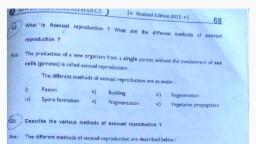Page 1 :
AIM, Studying binary fission in (a) Amoeba and (b) budding in Yeast and Hydra with the help of prepared slides.
Page 2 :
MATERIALS REQUIRED, Permanent slides of various stages of budding in Yeast, budding in Hydra, and binary fission in Amoeb, compound microscope, note-book, pencil.
Page 3 :
PROCEDURE, O Place the permanent slides of budding in yeast and binary fission in Amoeba one by one under a compound, microscope., a Observe the slides first under low power and then under high power., O Note the features of reproduction stages of organism, make rough sketches and then compare these with, the diagrams given in the practical record file., a Make neat and labelled diagrams in the practical record file., OBSERVATIONS, (a) Binary Fission in Amoeba : The prepared permanent slides showing binary fission in amoeba under, high power of a microscope depicts the following stages :, O During fission, the parent cell enlarges, elongates and the nucleus divides into two daughter nuclei., O It is followed by a transverse cytokinesis by the formation of a transverse septum., O The septum develops centripetally., O The septum results in the formation of two equal size daughter cells., O The two cells separate apart and behave as independent cells., Cell, membrane, Nucleus, 30, 60, Cytoplasm, (B), (C), (v), FIG. 3.2: (A - E) Stages of Binary Fission in Am, ba, (b) Budding in Yeast : The prepared permanent slides showing budding in yeast cell, under high power of, a microscope depicts the following stages :, O A small bud like outgrowth initiates at one end of the parent cell., OThe bud enlarges in size., O The nucleus enlarges and divides by the formation of a constriction in the middle., O One daughter nucleus goes into the bud and other remains in the parent cell., O Gradually bud becomes almost of the same size as the parent cell., O A constriction appears at the base and later a wall is laid down separating the bud from the parent cell., Daughter, Developing, spng, Elongation of Nucleus, png, Cytoplasm, Nucleus, Vacuole, Mother Cell, (A), (B), (D), FIG. 3.3: Stages of budding in veast, (E)
Page 4 :
Budding yeast cells, FIG. 3.4: Budding in yeast as seen under a microscope., (c) Budding in Hydra: The permanent slides showing budding in hydra under a microscope depicts the, following stages:, O A small projection or outgrowth appears on the parent body. This outgrowth is called a bud., O The bud enlarges in size., O The nucleus of the parent divides into two nuclei. One of these two nuclei enters in the bud., O The bud gradually increases in size, develops tentacles and becomes almost of the same size as the parent., Yound hydra, Bud, FIG. 3.5: Budding in Hydra, PRECAUTIONS, (i) Observe the slide first under low power and then under high power of microscope., (ii) First focus the slide by using coarse adjustment and then by using fine adjustment., (iii) The stages of budding in yeast and binary fission in amoeba are clearly visible under high power, microscope. For this fine adjustment knob should only be used for focusing., (iv) Adjust the light falling on the slide with the help of diaphragm., of

































































